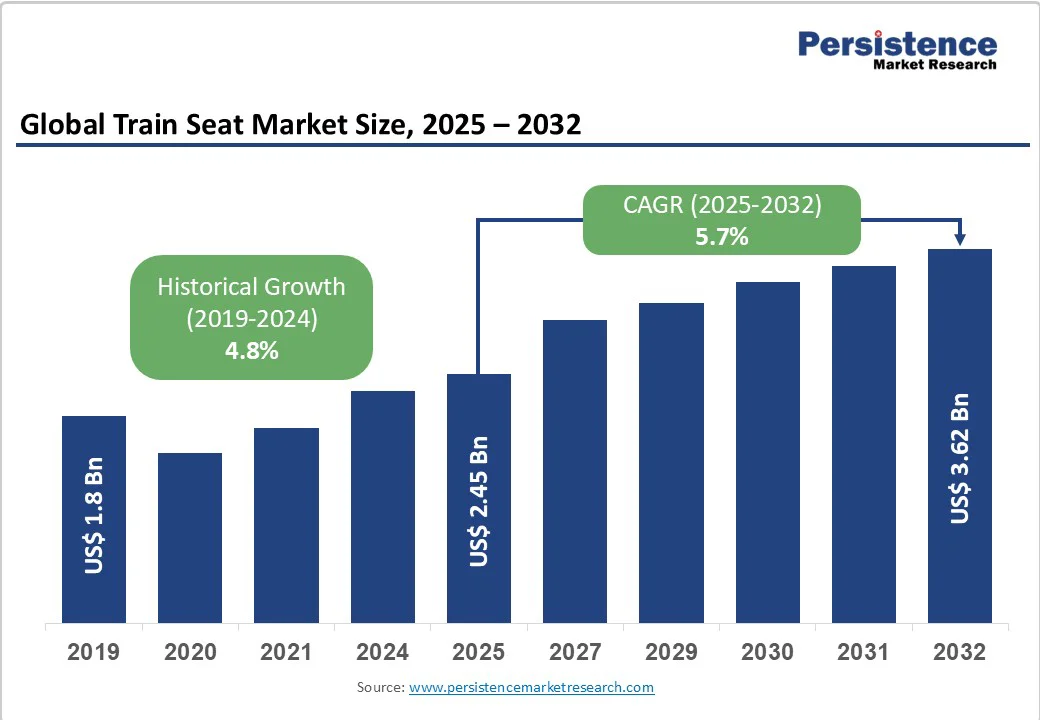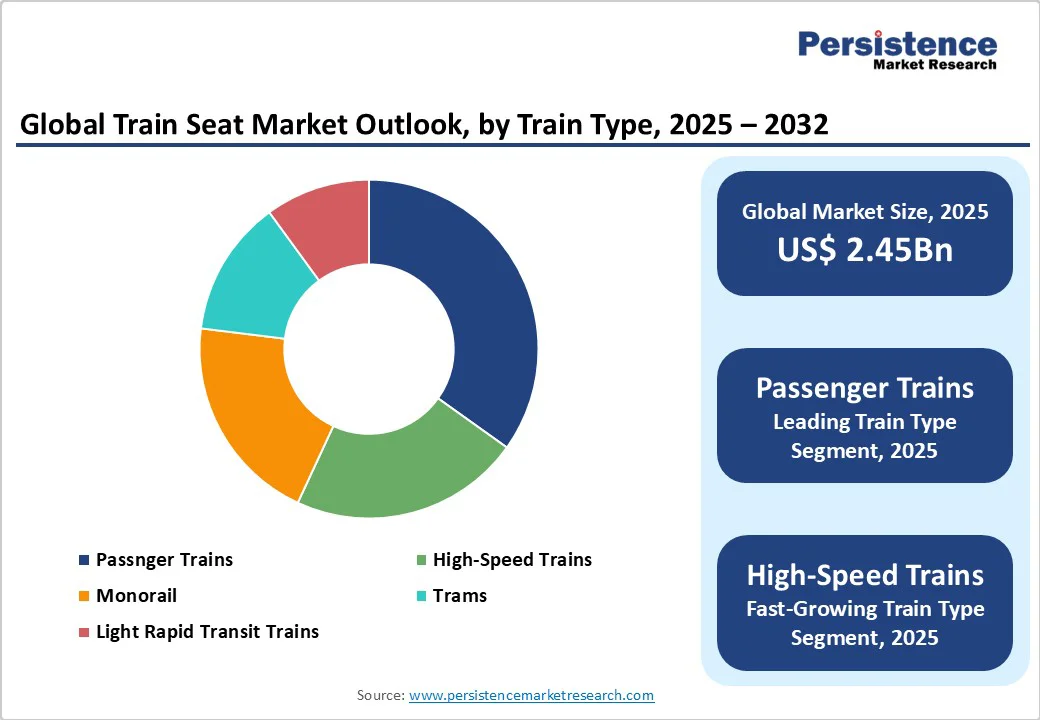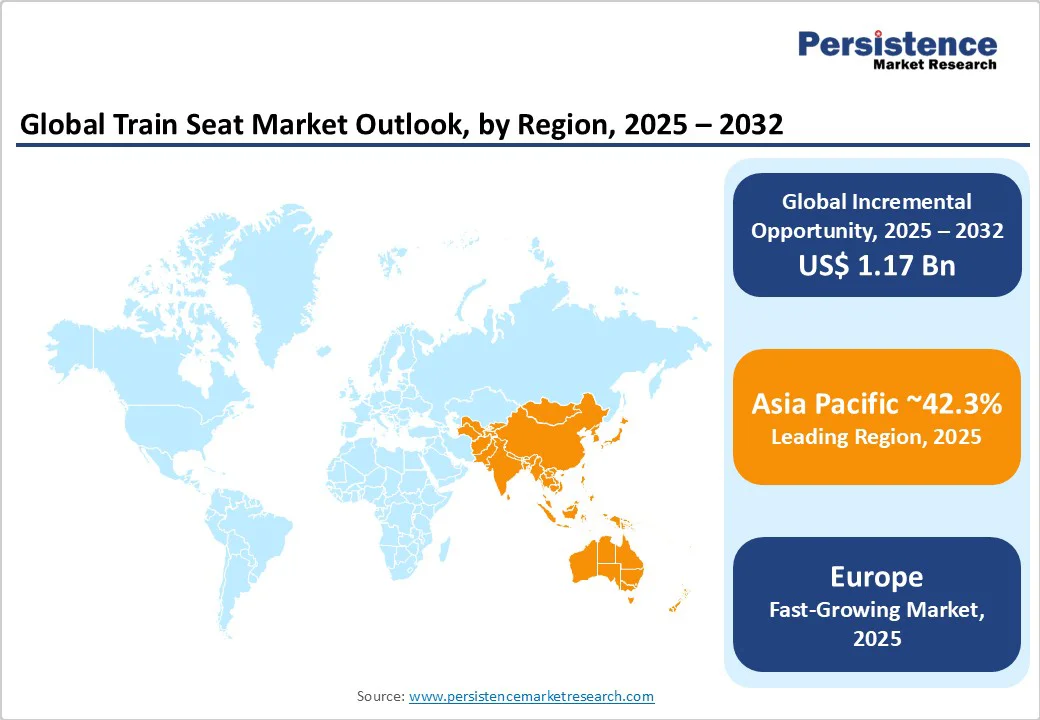ID: PMRREP5939| 198 Pages | 26 Sep 2025 | Format: PDF, Excel, PPT* | Automotive & Transportation

The global train seat market is projected to be valued at US$2.4 Bn in 2025 and is expected to reach US$3.6 Bn by 2032, growing at a CAGR of 5.7% during the forecast period from 2025 to 2032.
The train seat market is experiencing robust growth, driven by increasing investments in railway infrastructure, rising demand for high-speed and urban transit systems, and a focus on passenger comfort and sustainability.
| Key Insights | Details |
|---|---|
| Train Seat Market Size (2025E) | US$ 2.45Bn |
| Market Value Forecast (2032F) | US$3.62Bn |
| Projected Growth (CAGR 2025 to 2032) | 5.7% |
| Historical Market Growth (CAGR 2019 to 2024) | 4.8% |

The global train seat market is experiencing significant growth due to substantial investments in railway infrastructure and rapid urbanization worldwide. Train seats are essential for ensuring passenger comfort and safety across various rail systems, including high-speed trains and urban transit.
According to the International Transport Forum, global railway infrastructure investments are projected to reach $38 billion in 2025, with significant contributions from emerging economies. In the Asia Pacific, China’s Belt and Road Initiative and India’s Dedicated Freight Corridor project are driving demand for advanced train seats.
In Europe, the EU’s Trans-European Transport Network (TEN-T) aims to enhance rail connectivity, increasing the need for ergonomic and durable seats. Companies such as Grammer AG reported sales increases in rail seating solutions in 2024, reflecting the growing demand. Government-led initiatives, such as Japan’s Shinkansen expansion, ensure sustained market growth, positioning railway infrastructure as a key driver through 2032.
The train seat market faces challenges due to high manufacturing costs and competition from alternative materials. Producing ergonomic, fire-resistant, and lightweight seats requires advanced materials such as composites and high-grade foams, which are costly. In 2023, raw material price volatility, particularly for polyurethane and steel, increased production costs by 8%, impacting manufacturers’ margins.
Additionally, alternative seating solutions, such as those made from recycled plastics or bio-based materials, are gaining traction due to their lower cost and sustainability appeal. Limited standardization across regions and stringent regulatory requirements for fire safety and durability further increase costs, particularly for smaller manufacturers. These factors create pricing pressures and limit market accessibility in cost-sensitive regions, restraining overall growth.
The increasing focus on sustainability and smart technologies presents significant opportunities for growth. Passengers and operators are prioritizing eco-friendly and technologically advanced seating solutions. Train seats made from recyclable materials and equipped with smart features, such as integrated sensors for occupancy detection, are gaining popularity. The International Energy Agency projects a 60% increase in global rail passenger traffic by 2030, driven by sustainable transport initiatives.
In Europe, the EU’s Green Deal promotes low-carbon rail systems, encouraging manufacturers such as Camira Fabrics to develop eco-friendly upholstery. In the Asia Pacific, Japan’s adoption of smart seats with adjustable lumbar support and USB charging ports is driving innovation. Companies such as Lantal Textiles AG are investing in lightweight, recyclable materials to align with sustainability trends, creating opportunities for market expansion through 2032.

The Asia Pacific region holds a commanding lead in the global train seat market, capturing 42.3% share in 2025. This dominance is fueled by the region’s extensive and rapidly expanding railway networks, propelled by fast-paced urbanization and massive government investments, especially in powerhouses such as China and India. China, the world’s largest rail market, recorded over 4.3 billion passenger trips in 2024, a remarkable 11.9% year-over-year increase, underscoring the growing demand for reliable and comfortable seating.
India's ambitious railway modernization, highlighted by flagship projects such as the Vande Bharat Express, has intensified the need for ergonomic and durable train seats that enhance passenger comfort on long-distance routes. Additionally, the Asia Pacific’s high-speed rail initiatives, often incorporating Japan’s advanced Shinkansen technology, drive demand for premium and luxury seating solutions. Industry leaders such as Harita Seating System Limited and Fenix Group LLC are capitalizing on the region’s low-cost manufacturing capabilities and government support, positioning themselves to sustain robust market growth through 2032.
Europe is expected to be the fastest-growing market in 2025, driven by a combination of stringent safety standards, sustainability mandates, and substantial investments in high-speed rail and urban transit infrastructure. The European railway market, particularly in countries such as Germany and France, is experiencing increased demand for advanced seating solutions designed to meet modern passenger expectations. Germany’s Deutsche Bahn and France’s SNCF, operators of iconic high-speed trains such as the ICE and TGV, are prioritizing seats that emphasize ergonomics, durability, and eco-friendliness.
The European Union’s Green Deal further accelerates this trend by promoting sustainable rail transport, encouraging manufacturers to develop recyclable, lightweight, and energy-efficient seating options. Leading companies such as Camira Fabrics and Kiel Group are at the forefront, supplying innovative materials and designs that comply with evolving regulatory frameworks. Europe’s commitment to passenger comfort, environmental responsibility, and safety standards is set to drive sustained growth through 2032, positioning it as a hub of innovation and excellence.
North America is the second-fastest-growing region, driven by robust investments in both urban transit and freight rail systems across the U.S. and Canada. The U.S. freight rail industry alone contributed an impressive $233.4 billion in total economic output in 2023, supporting nearly 750,000 jobs, according to a 2025 report by the Association of American Railroads (AAR).
This economic strength underscores the critical role rail plays in the region’s infrastructure. In Canada, initiatives led by Via Rail and ongoing urban transit projects in major cities such as Toronto are boosting demand for ergonomic and durable seating solutions designed to enhance passenger comfort.
Market leaders such as Seats Incorporated and The CE White Co. dominate this space, leveraging extensive distribution networks and participating in major infrastructure upgrades, including Amtrak’s Acela high-speed train enhancements. Consumer demand for sustainable, comfortable seating options, combined with consistent government funding for rail modernization, is set to solidify North America’s market growth through 2032.

The global train seat market is highly competitive and fragmented, with a mix of established players and regional manufacturers. Leading companies such as Grammer AG, Saira Seats Limited, and Seats Incorporated dominate through extensive product portfolios, focusing on ergonomic and sustainable seating solutions.
Regional players such as Harita Seating System Limited cater to localized demand in the Asia Pacific. Manufacturers are investing in lightweight materials, smart technologies, and eco-friendly upholstery to enhance market share, driven by demand for high-performance seats in high-speed and urban transit systems.
The train seat market is projected to reach US$2.45 Bn in 2025.
Rising investments in railway infrastructure, urbanization, and demand for sustainable seating solutions are the key market drivers.
The train seat market is poised to witness a CAGR of 5.7% from 2025 to 2032.
The growing demand for sustainable and smart seating solutions is the key market opportunity.
Grammer AG, Saira Seats Limited, Seats Incorporated, and Lantal Textiles AG are key market players.
| Report Attribute | Details |
|---|---|
| Historical Data/Actuals | 2019 - 2024 |
| Forecast Period | 2025 - 2032 |
| Market Analysis | Value: US$ Bn/Mn, Volume: As Applicable |
| Geographical Coverage |
|
| Segmental Coverage |
|
| Competitive Analysis |
|
| Report Highlights |
|
By Train Type
By Product
By Region
Delivery Timelines
For more information on this report and its delivery timelines please get in touch with our sales team.
About Author